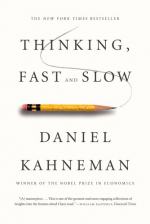
|
| Name: _________________________ | Period: ___________________ |
This test consists of 15 multiple choice questions and 5 short answer questions.
Multiple Choice Questions
1. Who wrote the 2005 book Expert Political Judgment: How Good Is It? How Can We Know?
(a) Philip Tetlock.
(b) Baruch Fischhoff.
(c) Malcolm Gladwell.
(d) Jim Collins and Jerry I. Porras.
2. What aspect of the mind answers the question: "How was it, on the whole" (734)?
(a) The remembering self.
(b) The anchoring self.
(c) The experiencing self.
(d) The loss-aversive self.
3. The author states in the opening of Chapter 29, "Whenever you form a global evaluation of a complex object--a car you may buy, your son-in-law, or an uncertain situation--you" do what (600)?
(a) "Seek advice from experience."
(b) "Evaluate the normalcy of the events or subjects."
(c) "Make immediate assumptions."
(d) "Assign weights to its characteristics."
4. Who coined the term "denominator neglect"?
(a) Shane Frederick.
(b) John Gottman.
(c) Craig Fox.
(d) Paul Slovic.
5. What method is referred to by the author with the acronym DRM?
(a) Day Reconstruction Method.
(b) Detrimental Reliance Method.
(c) Dream Revival Method.
(d) Diagnostic Reconstruction Method.
6. In one example provided by the author in Chapter 31, he establishes two sports fans going to a game while facing a blizzard. One bought his ticket and the other one got his for free from a friend. The author asserts that the fan who paid is more likely to drive. What provides the explanation for this assertion?
(a) Narrative fallacy.
(b) The availability cascade.
(c) An anchoring effect.
(d) Mental accounting.
7. What creates an asymmetry that makes agreements difficult to reach?
(a) Endowment effect.
(b) Theory-induced blindness.
(c) Loss aversion.
(d) Narrative fallacy.
8. Who is the author of Clinical vs. Statistical Prediction: A Theoretical Analysis and a Review of the Evidence?
(a) Malcolm Gladwell.
(b) Baruch Fischhoff.
(c) Jerry I. Porras.
(d) Paul Meehl.
9. Who is the author of Introduction to the Principles of Morals and Legislation?
(a) Baruch Fischhoff.
(b) Shane Frederick.
(c) Jeremy Bentham.
(d) John List.
10. The author presents several examples in Chapter 26 that demonstrate that there is no loss aversion in what kinds of interactions?
(a) Routine commercial exchanges.
(b) Gambling exchanges.
(c) Large investments in similar firms.
(d) Non-material interactions.
11. How are decision weights and probabilities regarded in prospect theory?
(a) Weights are more important.
(b) Probabilities are more important.
(c) The same.
(d) Variations of probability have less effect on decision weights.
12. What nineteenth-century British economist proposed the idea of a "hedonimeter"?
(a) Baruch Fischhoff.
(b) John List.
(c) Francis Edgeworth.
(d) Shane Frederick.
13. According to the author in Chapter 26, "In bad choices, where a sure loss is compared to a larger loss that is merely probable," what is the result (552)?
(a) "Diminishing sensitivity causes risk seeking."
(b) "Loss aversion causes narrative fallacies."
(c) "Loss aversion causes extremely risk-averse choices."
(d) "Risk seeking behavior causes extremely loss aversive choices."
14. Given the following information, what percentage of respondents answered Mr. Brown? "Mr. Brown almost never picks up hitchhikers. Yesterday he gave a man a ride and was robbed" and "Mr. Smith frequently picks up hitchhikers. Yesterday he gave a man a ride and was robbed" (666)?
(a) 88%.
(b) 16%.
(c) 95%.
(d) 45%.
15. When did the CIA obtain information that al-Qaeda might be planning a major attack against the United States?
(a) July 10, 2001.
(b) March 12, 2001.
(c) September 9, 2001.
(d) January 2, 2000.
Short Answer Questions
1. Who was concluded to achieve better investment results in "Boys Will Be Boys"?
2. Who is the author of A Random Walk Down Wall Street?
3. What psychologist conduted an experiment wherein he recruited fans of professional basketball and elicited judgments concerning the winner of the NBA playoffs?
4. What organization paid for Thaler to spend a year working with Kahneman in Vancouver?
5. In the following example from Chapter 30, the author posits the following in regards to a person choosing a marble from an urn. The red marbles win a prize. "Urn A contains 10 marbles, of which 1 is red. Urn B contains 100 marbles, of which 8 are red" (631). What are the chances of winning in Urn B?
|
This section contains 620 words (approx. 3 pages at 300 words per page) |

|




